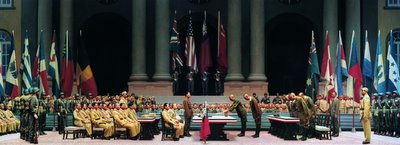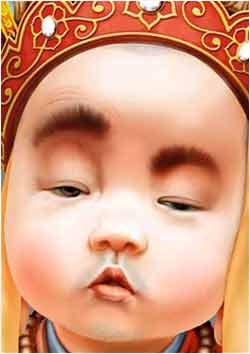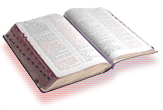Who really fought the Sino-Japanese War?
From Answers.com, not very new
(Japan surrenders to China on 9 September 1945.)
The question as to which political group directed the Chinese war effort and exerted most of the effort to resist the Japanese still remains a controversial issue.
In the Chinese People's Anti-Japanese War of Resistance Memorial near the Marco Polo Bridge, the People's Republic of China emphasizes that it was the Communist Party that directed Chinese efforts in the war and did everything to resist the Japanese invasion. Recently, however, with a change in the political climate, the CCP has admitted that certain Nationalist generals made important contributions in resisting the Japanese. The official consensus in mainland China is that the KMT fought a bloody, yet indecisive, frontal war against Japan, while it was the CCP that engaged the Japanese forces in far greater numbers behind enemy lines. This emphasis on the CCP's central role is partially reflected by the PRC's labeling of the war as the Chinese People's Anti-Japanese War of Resistance rather than merely the War of Resistance. According to the PRC official point of view, the Nationalists/Kuomintang mostly avoided fighting the Japanese in order to preserve its strength for a final showdown with the Communists.
Leaving aside Nationalists sources, scholars researching third party Japanese and Soviet sources have documented quite a different view. Such studies claim that the Communists actually played a miniscule involvement in the war against the Japanese compared to the Nationalists and used guerilla warfare as well as opium sales to preserve its strength for a final showdown with the Kuomintang. The Communists were not the main participants in any of the 22 major battles, most involving more than 100,000 troops on both sides, between China and Japan. Soviet liaison to the Chinese Communists Peter Vladimirov documented that he never once found the Chinese Communists and Japanese engaged in battle during the period from 1942 to 1945. He also expressed frustration at not being allowed by the Chinese Communists to visit the frontline, although as a foreign diplomat Vladimirov may have been overly optimistic to expect to be allowed to join Chinese guerrilla sorties. The Communists usually avoided open warfare (the Hundred Regiments Campaign and the Battle of Pingxingguan are notable exceptions), preferring to fight in small squads to harass the Japanese supply lines. As a result, their contributions cannot be measured the same way the Nationalists' can. In comparison, the Nationalists committed their best troops (including the 36th, 83rd, 88th divisions, the crème de la crème and Chiang's personal elite troops) to defend Shanghai from the Japanese, a third of whom were killed or wounded. The Japanese considered the Kuomintang rather than the Communists as their main enemy and bombed the Nationalist wartime capital of Chongqing to the point that it is the most heavily bombed city in the world to date. Also, the main bulk of Japanese forces were fighting mainly in Central and Southern China, away from any major communist strongholds such as those in Shaanxi.
A third perspective advocated by some historians is that the warlords actually did most of the fighting with the Japanese, considering that a large part the National Revolutionary Army was actually composed of troops from different factions (including the communists). While the Communists and Nationalists tried to preserve their troop strengths for a final showdown with each other and therefore failed to resist the Japanese to the fullest, the warlords had no choice but to commit everything to the defence of the territories that they jealously controlled. This perspective is not as well-known because both the Nationalists and Communists were against the warlords and the warlords were unlikely to have well-documented, extensive archives that the Nationalists and Communists have.
Major figures
China: Nationalist
Bai Chongxi (白崇禧,白崇禧)
Chen Cheng (陈诚,陳誠)
Chiang Kai-Shek (蒋介石,蔣介石)
Du Yuming (杜聿明,杜聿明)
Fang Xianjue (方先觉,方先覺)
Feng Yuxiang (冯玉祥,馮玉祥)
Gu Zhutong (顾祝同,顧祝同)
He Yingqin (何应钦,何應欽) Chairman of the Joint Chiefs of Staff of Republic of China
H. H. Kung (孔祥熙,孔祥熙)
Hu Zongnan (胡宗南)
Li Zongren (李宗仁)
Long Yun (龙云,龍雲)
Song Zheyuan (宋哲元,宋哲元)
Soong May-ling (宋美龄,宋美齡)
T. V. Soong (宋子文)
Sun Lianzhong (孙连仲,孫連仲)
Sun Liren (孙立人,孫立人)
Tang Enbai (汤恩伯,湯恩伯)
Tang Shengzhi (唐生智,唐生智)
Wang Jingwei (汪精卫,汪精衛)
Wei Lihuang (卫立煌,衛立煌)
Xue Yue (薛岳)
Yan Xishan (阎锡山,閻錫山)
Xie Jinyuan (谢晋元,謝晉元)
Ye Ting (叶挺)
Zhang Zhizhong (张治中,張治中)
Zhang Zizhong (张自忠,張自忠)
China: Communist
Chen Yi (陈毅,陳毅)
Deng Xiaoping (邓小平,鄧小平)
He Long (贺龙)
Lin Biao (林彪)
Liu Bocheng (刘伯承,劉伯承)
Liu Shaoqi (刘少奇,劉少奇)
Luo Ronghuan (罗荣桓,羅榮桓)
Mao Zedong (毛泽东,毛澤東)
Nie Rongzhen (聂荣臻,聶榮臻)
Peng Dehuai (彭德怀,彭德懷)
Su Yu (粟裕,粟裕)
Xu Xiangqian (徐向前)
Ye Jianying (叶剑英)
Zhou Enlai (周恩来,周恩來)
Zhu De (朱德)
Japan
Anami Korechika (阿南惟幾)
Abe Nobuyuki (阿部信行)
Doihara Kenji (土肥原 賢二)
Fumimaro Konoe (近衛 文麿)
Kanji Ishiwara (石原莞爾)
Koiso Kuniaki (小磯國昭)
Hata Shunroku (畑 俊六)
Honma Masaharu (本間雅晴)
Isogai Rensuke (磯谷廉介)
Itagaki Seishiro (板垣征四郎)
Matsui Iwane (松井石根)
Mutaguchi Renya (牟田口 廉也)
Nakajima Kesago (中島今朝吾)
Nagumo Chuichi (南雲忠一)
Nishio Toshizo (西尾壽造)
Nomura Kichisaburo (野村吉三郎)
Okamura Yasuji (岡村寧次)
Umezu Yoshijiro (梅津美治郎)
Sakai Takashi (酒井隆)
Sugiyama Hajime (杉山元)
Suzuki Kantaro (鈴木貫太郎)
Terauchi Hisaichi (寺内寿一)
Tojo Hideki (東條英機)
Yamaguchi Tamon (山口多聞)
Yamamoto Isoroku (山本五十六)
Yamashita Tomoyuki (山下奉文)
Kingoro Hashimoto
Others
Norman Bethune
Alexander von Falkenhausen
Claire Chennault
Joseph Stilwell
Albert Coady Wedemeyer
John Rabe
Military engagements
Campaigns
Burma-Yunnan Campaign
Honan-Hupeh Campaign
Western Hunan Campaign
Japanese Campaigns in Chinese War
Battles
Battle of Lugou Bridge
Battle of Shanghai
Battle of Nanjing (also known as the Defense of Nanjing)
Battle of Taierzhuang
Battle of Xuzhou
Battle of Wuhan
Battle of Changsha
Retreat of Xianggui
Battle of Hengyang
Hundred Regiments Offensive
Battle of Sinkow
Battle of Hsuchow
Battle of Wuchang and Hankow
Battle of Nanchang
Battle of Suixian-Zaoyang
Battle of Southern Kwangsi
Battle of Tsaoyang-Ichang
Battle of South Honan
Battle of Shangkao
Battle of Southern Shansi
Battle of Chekiang-Kiangsi
Battle of Western Hupeh
Battle of Changteh
Battle of Central Honan
Battle of Central Hunan
Battle of Kwangsi-Kewichow
Battle of West Hupei
Battle of Chungyuang
Battle of Changteh
Battle of Hunan
Battle of Beijing-Hankow Rails
Battle of West Hopei
Battle of Changsa-Hengyang
Battle of Kweilin-Liuchow
Battle of Lungling
Battle of Tengchung
Battle of Wanting
Battle of North Hupei
Battle of West Honan
Battle of West Hunan
Battle of Ninhsiang
Battle of Yiyang
Battle of Wuyang
Battle of Nanning
Battle of Liuchow
Battle of Kweiling
Battle of Tengchung
Battle of Lungling
Battle of Beijing-Tientsin
Battle of Linchi
Battle of North Ahnwei
Battle of West Shangtung
Battle of Lutsun
Battle of Lienshui
Battle of Laohoko
Battle of Hsueh-Feng Shan
Battle of Hsihsiakao
Battle of Xiushui River
Battle of Jehol
First Battle of Hopei
Szechwan Invasion
Battle of Pingxingguan
Battles in Burmese Campaign
Battle of Maingkwan
Battle of Mogaung
Battle of Myitkyina
Battle of Mongyu
Battle of Lashio
Battle of Hsipai
Attacks on civilians
Nanjing Massacre
Unit 731
Unit 100
Unit 516
Unit 1855
Unit 2646
Unit 8604
Unit 9420
Unit Ei 1644
Comfort women
Tongzhou Incident
Shantung Incident
Taihoku Air Strike
Bombing of Chongqing
Kaimingye germ weapon attack
Changteh Chemical Weapon Attack
Sook Ching Massacre (against overseas Chinese)

The question as to which political group directed the Chinese war effort and exerted most of the effort to resist the Japanese still remains a controversial issue.
In the Chinese People's Anti-Japanese War of Resistance Memorial near the Marco Polo Bridge, the People's Republic of China emphasizes that it was the Communist Party that directed Chinese efforts in the war and did everything to resist the Japanese invasion. Recently, however, with a change in the political climate, the CCP has admitted that certain Nationalist generals made important contributions in resisting the Japanese. The official consensus in mainland China is that the KMT fought a bloody, yet indecisive, frontal war against Japan, while it was the CCP that engaged the Japanese forces in far greater numbers behind enemy lines. This emphasis on the CCP's central role is partially reflected by the PRC's labeling of the war as the Chinese People's Anti-Japanese War of Resistance rather than merely the War of Resistance. According to the PRC official point of view, the Nationalists/Kuomintang mostly avoided fighting the Japanese in order to preserve its strength for a final showdown with the Communists.
Leaving aside Nationalists sources, scholars researching third party Japanese and Soviet sources have documented quite a different view. Such studies claim that the Communists actually played a miniscule involvement in the war against the Japanese compared to the Nationalists and used guerilla warfare as well as opium sales to preserve its strength for a final showdown with the Kuomintang. The Communists were not the main participants in any of the 22 major battles, most involving more than 100,000 troops on both sides, between China and Japan. Soviet liaison to the Chinese Communists Peter Vladimirov documented that he never once found the Chinese Communists and Japanese engaged in battle during the period from 1942 to 1945. He also expressed frustration at not being allowed by the Chinese Communists to visit the frontline, although as a foreign diplomat Vladimirov may have been overly optimistic to expect to be allowed to join Chinese guerrilla sorties. The Communists usually avoided open warfare (the Hundred Regiments Campaign and the Battle of Pingxingguan are notable exceptions), preferring to fight in small squads to harass the Japanese supply lines. As a result, their contributions cannot be measured the same way the Nationalists' can. In comparison, the Nationalists committed their best troops (including the 36th, 83rd, 88th divisions, the crème de la crème and Chiang's personal elite troops) to defend Shanghai from the Japanese, a third of whom were killed or wounded. The Japanese considered the Kuomintang rather than the Communists as their main enemy and bombed the Nationalist wartime capital of Chongqing to the point that it is the most heavily bombed city in the world to date. Also, the main bulk of Japanese forces were fighting mainly in Central and Southern China, away from any major communist strongholds such as those in Shaanxi.
A third perspective advocated by some historians is that the warlords actually did most of the fighting with the Japanese, considering that a large part the National Revolutionary Army was actually composed of troops from different factions (including the communists). While the Communists and Nationalists tried to preserve their troop strengths for a final showdown with each other and therefore failed to resist the Japanese to the fullest, the warlords had no choice but to commit everything to the defence of the territories that they jealously controlled. This perspective is not as well-known because both the Nationalists and Communists were against the warlords and the warlords were unlikely to have well-documented, extensive archives that the Nationalists and Communists have.
Major figures
China: Nationalist
Bai Chongxi (白崇禧,白崇禧)
Chen Cheng (陈诚,陳誠)
Chiang Kai-Shek (蒋介石,蔣介石)
Du Yuming (杜聿明,杜聿明)
Fang Xianjue (方先觉,方先覺)
Feng Yuxiang (冯玉祥,馮玉祥)
Gu Zhutong (顾祝同,顧祝同)
He Yingqin (何应钦,何應欽) Chairman of the Joint Chiefs of Staff of Republic of China
H. H. Kung (孔祥熙,孔祥熙)
Hu Zongnan (胡宗南)
Li Zongren (李宗仁)
Long Yun (龙云,龍雲)
Song Zheyuan (宋哲元,宋哲元)
Soong May-ling (宋美龄,宋美齡)
T. V. Soong (宋子文)
Sun Lianzhong (孙连仲,孫連仲)
Sun Liren (孙立人,孫立人)
Tang Enbai (汤恩伯,湯恩伯)
Tang Shengzhi (唐生智,唐生智)
Wang Jingwei (汪精卫,汪精衛)
Wei Lihuang (卫立煌,衛立煌)
Xue Yue (薛岳)
Yan Xishan (阎锡山,閻錫山)
Xie Jinyuan (谢晋元,謝晉元)
Ye Ting (叶挺)
Zhang Zhizhong (张治中,張治中)
Zhang Zizhong (张自忠,張自忠)
China: Communist
Chen Yi (陈毅,陳毅)
Deng Xiaoping (邓小平,鄧小平)
He Long (贺龙)
Lin Biao (林彪)
Liu Bocheng (刘伯承,劉伯承)
Liu Shaoqi (刘少奇,劉少奇)
Luo Ronghuan (罗荣桓,羅榮桓)
Mao Zedong (毛泽东,毛澤東)
Nie Rongzhen (聂荣臻,聶榮臻)
Peng Dehuai (彭德怀,彭德懷)
Su Yu (粟裕,粟裕)
Xu Xiangqian (徐向前)
Ye Jianying (叶剑英)
Zhou Enlai (周恩来,周恩來)
Zhu De (朱德)
Japan
Anami Korechika (阿南惟幾)
Abe Nobuyuki (阿部信行)
Doihara Kenji (土肥原 賢二)
Fumimaro Konoe (近衛 文麿)
Kanji Ishiwara (石原莞爾)
Koiso Kuniaki (小磯國昭)
Hata Shunroku (畑 俊六)
Honma Masaharu (本間雅晴)
Isogai Rensuke (磯谷廉介)
Itagaki Seishiro (板垣征四郎)
Matsui Iwane (松井石根)
Mutaguchi Renya (牟田口 廉也)
Nakajima Kesago (中島今朝吾)
Nagumo Chuichi (南雲忠一)
Nishio Toshizo (西尾壽造)
Nomura Kichisaburo (野村吉三郎)
Okamura Yasuji (岡村寧次)
Umezu Yoshijiro (梅津美治郎)
Sakai Takashi (酒井隆)
Sugiyama Hajime (杉山元)
Suzuki Kantaro (鈴木貫太郎)
Terauchi Hisaichi (寺内寿一)
Tojo Hideki (東條英機)
Yamaguchi Tamon (山口多聞)
Yamamoto Isoroku (山本五十六)
Yamashita Tomoyuki (山下奉文)
Kingoro Hashimoto
Others
Norman Bethune
Alexander von Falkenhausen
Claire Chennault
Joseph Stilwell
Albert Coady Wedemeyer
John Rabe
Military engagements
Campaigns
Burma-Yunnan Campaign
Honan-Hupeh Campaign
Western Hunan Campaign
Japanese Campaigns in Chinese War
Battles
Battle of Lugou Bridge
Battle of Shanghai
Battle of Nanjing (also known as the Defense of Nanjing)
Battle of Taierzhuang
Battle of Xuzhou
Battle of Wuhan
Battle of Changsha
Retreat of Xianggui
Battle of Hengyang
Hundred Regiments Offensive
Battle of Sinkow
Battle of Hsuchow
Battle of Wuchang and Hankow
Battle of Nanchang
Battle of Suixian-Zaoyang
Battle of Southern Kwangsi
Battle of Tsaoyang-Ichang
Battle of South Honan
Battle of Shangkao
Battle of Southern Shansi
Battle of Chekiang-Kiangsi
Battle of Western Hupeh
Battle of Changteh
Battle of Central Honan
Battle of Central Hunan
Battle of Kwangsi-Kewichow
Battle of West Hupei
Battle of Chungyuang
Battle of Changteh
Battle of Hunan
Battle of Beijing-Hankow Rails
Battle of West Hopei
Battle of Changsa-Hengyang
Battle of Kweilin-Liuchow
Battle of Lungling
Battle of Tengchung
Battle of Wanting
Battle of North Hupei
Battle of West Honan
Battle of West Hunan
Battle of Ninhsiang
Battle of Yiyang
Battle of Wuyang
Battle of Nanning
Battle of Liuchow
Battle of Kweiling
Battle of Tengchung
Battle of Lungling
Battle of Beijing-Tientsin
Battle of Linchi
Battle of North Ahnwei
Battle of West Shangtung
Battle of Lutsun
Battle of Lienshui
Battle of Laohoko
Battle of Hsueh-Feng Shan
Battle of Hsihsiakao
Battle of Xiushui River
Battle of Jehol
First Battle of Hopei
Szechwan Invasion
Battle of Pingxingguan
Battles in Burmese Campaign
Battle of Maingkwan
Battle of Mogaung
Battle of Myitkyina
Battle of Mongyu
Battle of Lashio
Battle of Hsipai
Attacks on civilians
Nanjing Massacre
Unit 731
Unit 100
Unit 516
Unit 1855
Unit 2646
Unit 8604
Unit 9420
Unit Ei 1644
Comfort women
Tongzhou Incident
Shantung Incident
Taihoku Air Strike
Bombing of Chongqing
Kaimingye germ weapon attack
Changteh Chemical Weapon Attack
Sook Ching Massacre (against overseas Chinese)












































0 Comments:
Post a Comment
<< Home